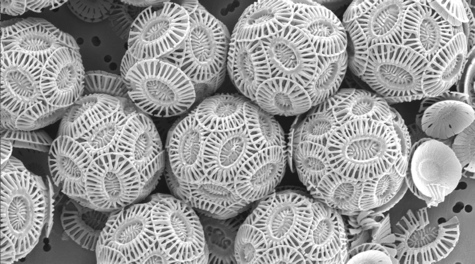
by Rick O'Connor | Nov 22, 2024
You may ask – “what are protozoans?” It’s a good question. The breakdown of the word includes “proto” which means “before”, and “zoan” which refers to animals. These are the “before animals” – meaning animal-like creatures BEFORE there were true animals.
They are single celled creatures that lack a cell wall and chlorophyll – animal-like – but they are only single celled – so, not true animals. Being animal-like means they cannot produce their own food as the diatoms, dinoflagellates, seaweeds, and true plants do. Rather, they must consume food as animals do. Some feed on diatoms and dinoflagellates. Some feed on decaying organic matter from the seafloor. Some are parasitic and feed off a host organism. Some feed on other protozoans. And some do a combination. But they are all consumers.
The group is classified into six phyla mostly based on how they move. One subphylum is the Mastiogophorans – which move using flagella. Flagella are long whip-like tails that extend from the cell and can “twirled” in a fashion that will help the cell move around in the environment. Flagellates can have one or many flagella. Most are not free-swimming in the water column but live on the bottom or are parasitic. Two groups common in marine waters are the choanoflagellates and the coccolithophores.
Choanoflagellates are cells that usually possess one flagella that is protected by a funnel shaped structure called a collar. They are often called “collar cells”. Though found in many benthic environments they are most famous for their role in sponges. Here they live within the walls of the sponge, twirling their flagella to generate a current that draws water into the sponge for feeding. The currents generated by the choanoflagellates also move waste and reproductive gametes out of the sponge into the environment.
Coccolithophores are flagellated protozoans covered by calcium carbonate plates. These are more common in the plankton of the Gulf of Mexico and play an important role in the carbon cycle. They convert CO2 into calcium carbonate, and other forms of carbon, reducing the CO2 levels in both the atmosphere and ocean, that plays a role in ocean acidification.

Coccolithophores are flagellated creatures covered in calcium carbonate plates.
Image: National Oceanic and Atmospheric Administration.
An interesting note here… when I was in college, we studied the dinoflagellates in both marine botany AND marine invertebrate zoology. I was quite confused… are they “plant-like” or “animal-like”? They could not be both… When I asked my marine botany professor she was adamant, they were part of the “plant world”. But my marine invertebrate zoology professor felt the same – they were definitely in the animal world. They both mentioned this was why they were listed in their own phylum and agreed to disagree. Dinoflagellates (which we have already covered in this series) do photosynthesize, and they do consume other plankton. The same is true for coccolithophores. A quick look on the internet they were described as “phytoplankton” not “zooplankton”. I am including them here – and know they are called coccolithophores. I also know they are one of the creatures found in the northern Gulf of Mexico.
References
Yaeger, R.G. 1996. Protozoa: Structure, Classification, Growth, and Development. Chapter 77. Medical Microbiology, 4th edition. https://www.ncbi.nlm.nih.gov/books/NBK8325/#A4082.
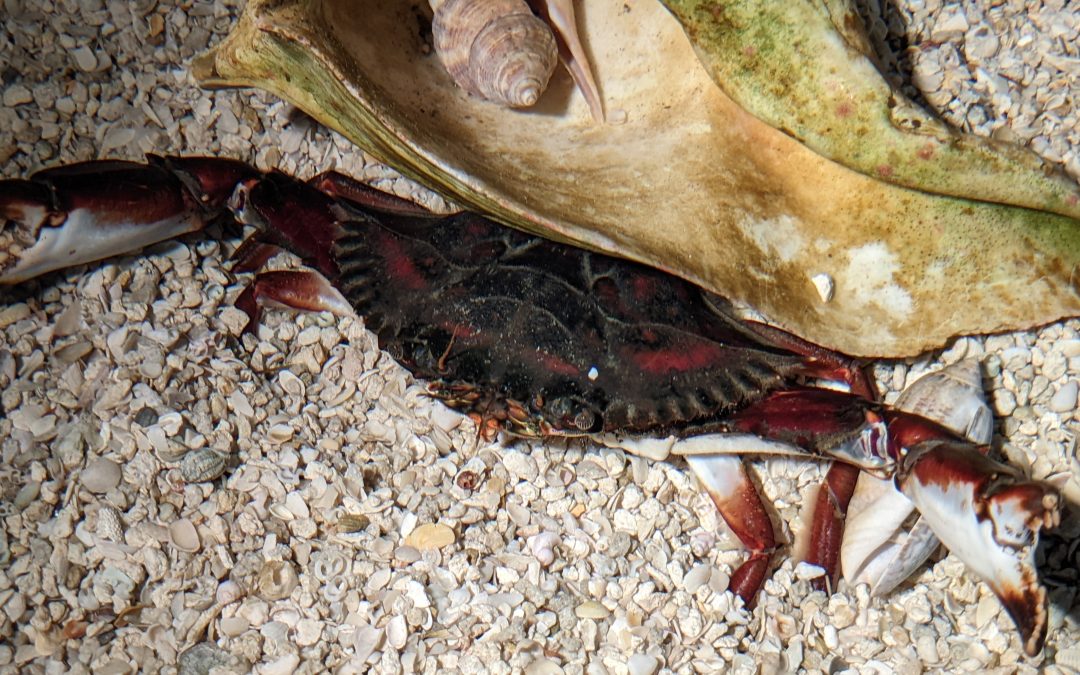
by Erik Lovestrand | Nov 22, 2024
In early November a local crabber, Kevin Martina, brought an interesting catch to the Franklin County Extension office in Apalachicola. Kevin and his brother Kenneth Martina fish for blue crabs in Apalachicola Bay and they came across what appeared at first glance to be a red-colored blue crab. In all their combined years of working crab pots, neither of them had seen a crab like this. On closer inspection at the Extension Office, there appeared to be some differences from a blue crab, other than the striking red coloration. It was the innate curiosity of our Extension Office Manager, Michelle Huber, that led us to the discovery that the crab was a species with a native range spanning Jamaica and Belize to Santa Caterina, Brazil. After Michelle showed photos of what she had found on her phone, we reached out to colleagues at the Apalachicola National Estuarine Research Reserve (ANERR) and told them we might have a Bocourt swimming crab (Callinectes bocourti). I told them that I could find no range maps indicating this species lived in our region. The nearest US Geological Survey data points for the species in the Gulf of Mexico were Alabama to the West and the Florida Everglades to the South. It was not long after the ANERR staff reached out to the Fish and Wildlife Conservation Commission that we received interest in confirming the identification and officially documenting the Bocourt swimming crab find.
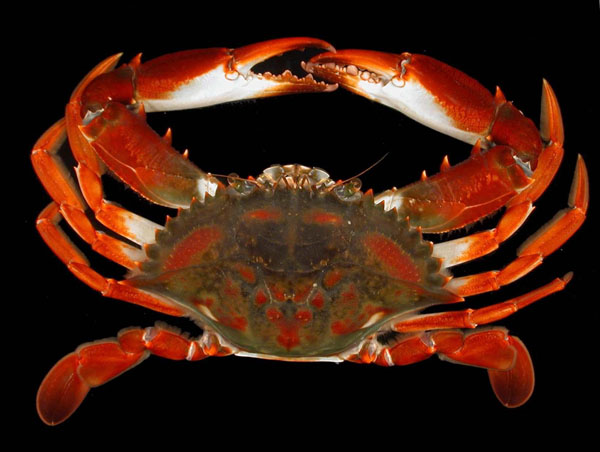
Bocourt Swimming Crab – USGS/South Carolina DNR
The first documented occurrence of a Bocourt swimming crab in the US happened in 1950 in South Florida. Since then, there have been rare finds in AL and MS and more common occurrences from South Florida all the way up to North Carolina on the Atlantic Coast. Theories about how they arrived include possible transport of larvae in ships’ ballast water or a natural expansion of range with the aid of various ocean currents like the Gulf Stream or by hitching a ride on floating debris from the Caribbean. Ecologically speaking, Bocourt crabs and our native blue crabs have virtually the same dietary habits and both species occur together throughout some parts of their native range. Even though there is likely some competition for food and refuge habitat, it doesn’t appear at this time that one of these crabs would dominate the ecosystem over the other. It also is not evident that Bocourt crabs are reproducing and established in the Northern Gulf of Mexico to-date.
If you are a commercial crabber in the Florida Panhandle, or happen to fish a few recreational traps, we would be interested to know if you have seen this species before. Location data and any good photos of specimens would go a long way to help monitor the species occurrence in our region. You can reach out to me at Elovestrand@ufl.edu or contact your local County Extension office to pass the info my way. Happy crabbing!
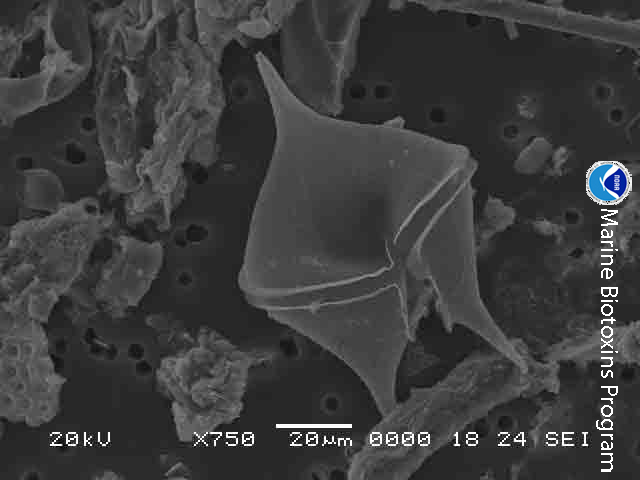
by Rick O'Connor | Nov 15, 2024
Much of the phytoplankton found in the waters for the northern Gulf of Mexico are diatoms and dinoflagellates. We wrote about diatoms in our last article, here we will meet the dinoflagellates.
Like diatoms, dinoflagellates are microscopic phytoplankton drifting in the surface waters of the Gulf by the billions. We mentioned how abundant diatoms were, in the warmer seas, dinoflagellates are even more abundant. You collect them using a plankton net as you would diatoms. Observing them under the microscope they differ in a couple of ways. One, their shell is not made of clear silica but rather plates of cellulose with silica mixed in. Like diatoms, dinoflagellates possess several forms of chlorophyll but instead of fucoxanthins they possess carotenoids – giving them a brownish/red color. They also possess two hair-like tails called flagella – hence their name “dinoflagellate”. One flagella extends head to tail, the other encircles the dinoflagellate across their “girdle”. These flagella allow the cells to adjust and orient their position in the water column.

Dinoflagellates are microscopic plant-like plankton that possess two flagella.
Image: National Oceanic and Atmospheric Administration.
As with diatoms, dinoflagellates exist in the sunlit surface waters serving as “grasses of the sea”. They are an important part of the food chain and, along with their diatom cousins, produce about 50% of the world’s oxygen. But some members of this group are known for other roles they play.
Karenia brevis is the dinoflagellate primarily responsible for red tide in Florida. A plankton tow will find these organisms are always present – usually 1,000 cells/liter of water or less. Under certain conditions, these dinoflagellates begin to replicate in great numbers. Their numbers are large enough that the water will often change to a “reddish” color. In this case we are talking 1 million cells/liter or more. When disturbed, they will secrete a toxin – brevotoxin. This toxin can cause a variety of issues for marine life – and humans. Gastrointestinal, neurological, and respiratory problems in humans have all been associated with it. Red tides are famous for the large fish kills they generate and the mortality in marine mammals.
Being “plant-like” warm waters, sunlight, and nutrients will trigger a bloom. These blooms have been occurring for centuries and were logged by the Spanish explorers. Often, they generate offshore where the sunlit calm waters of the Florida shelf are bathed in nutrients from ocean currents coming from the seafloor. When wind conditions are right – these offshore blooms move inshore where they meet the nutrient rich discharge from rivers and estuaries – enhancing the blooms. Much of this discharge has higher levels of nutrients due to the actions of humans – such as fertilizers, animal and human waste.
Red tides are quite common off southwest Florida – happing frequently during the winter months. In the northern Gulf they are not as common. We do get blooms occurring here, though most are in the eastern panhandle, but sometimes the weather will drive blooms generated in southwest Florida up our way.

The dinoflagellate Karenia brevis.
Photo: Smithsonian Marine Station-Ft. Pierce FL
Noctiluca scitillans is another dinoflagellate that locals may know about – but did know they were dinoflagellates. What you may know it for is its ability to produce bioluminescence – “light in the sea” – what many locals called “phosphorus” when I was a kid. When disturbed a chemical reaction will create a blueish colored light. We see it during warm summer evenings when we walk through the water – or our footprints in the sand. From a boat you can see the blue light as fish swim by, or the wake from the moving boat. I remember once in high school we did a night dive near a pier where the bioluminescence from these dinoflagellates was so bright that you could see other divers, fish, and the pier without a dive light. Jim Lovell, commander of Apollo 13, tells the story of a night bombing mission he participated during the Korean War where his navigation lights went out on the return trip. The carrier was running without lights to avoid detection, but Lovell found the ship by the bioluminescent trail left by the propeller churning these dinoflagellates. This dinoflagellate is found all over the world.
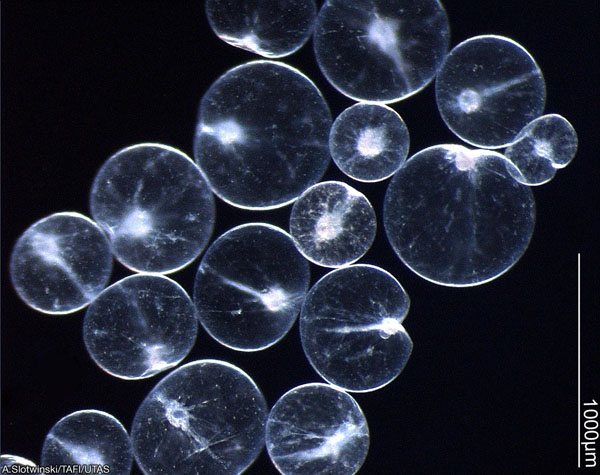
Noctiluca are one of the dinoflagellates that produce bioluminescence.
Photo: University of New Hampshire.
Zooxanthalle is a dinoflagellate you may not have heard of, but you may have heard of the coral bleaching that is occurring on reefs across the world. Corals are actually jellyfish and their tissue, like many jellyfish, is clear. The bright colors we are familiar with are caused by a symbiotic dinoflagellate that lives within the tissue of the corals. This symbiotic dinoflagellate is a group of several species known as zooxanthalle. In this partnership the photosynthetic zooxanthalle use waste products from the coral, and the sun, to photosynthesize. The products of photosynthesis are used to produce sugars, proteins, and other material that both the corals and the zooxanthalle need. Because of the need for sunlight, reefs usually occur in very clear – nutrient poor – waters. The bleaching we may be familiar with is caused when the reef is exposed to stress – high temperatures, pollutants, etc. and the zooxanthalle are expelled along with their photosynthetic pigments (the colors) – leaving only the clear tissue of the coral and a “white” appearance in color – bleaching.
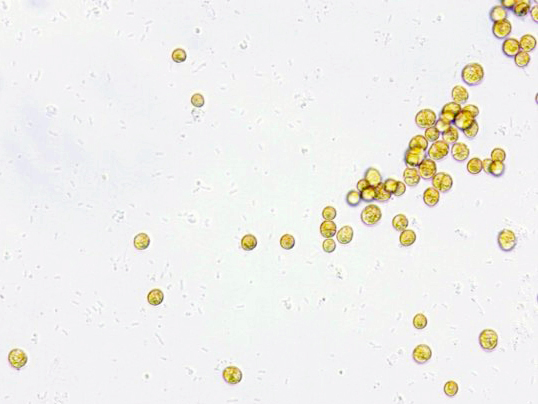
These symbiotic zooxanthalle cells are the ones that give corals their color.
Image: NOAA
There are at least 18 species of dinoflagellates in the genus Gambierdiscus. These are not free-floating dinoflagellates, but ones they live on the bottom. You may not know them by name, but you may know them from the toxins they release when stressed – ciguatoxin. Ciguatoxins are a type of neurotoxin that can cause several illness – even death – in humans. The concentrations of ciguatoxin at the cellular level are minor and do not cause problems. However, as organisms graze on these dinoflagellates the toxins are not expelled from their bodies but are rather stored in the tissue. As you move up the food chain, no creature expels the toxins, and the concentrations increase in a process known as bioaccumulation. For humans the danger lies in eating the top predators in the food chain where the concentrations of ciguatoxin are high enough to cause problems – a condition known as ciguatera. Many who have visited the tropical parts of the world – where Gambierdiscus is most common – may have heard “you should not eat the barracuda” – or other large predators caught on a reef.
This situation has not historically been an issue for the northern Gulf of Mexico, but there are now records of this dinoflagellate north of the Florida Keys – as far north as North Carolina along the east coast. Scientists are watching the movement of this tropical group of dinoflagellates as the oceans warm.

The dinoflagellate known as Gambierdiscus. Known to cause ciguatera.
Image: National Oceanic and Atmospheric Administration.
There are thousands more species of dinoflagellates in the Gulf, and know they play many important roles in the ecology of our marine environment.
Resources
National Oceanic and Atmospheric Administration (NOAA).
National Institute of Health (NIH).
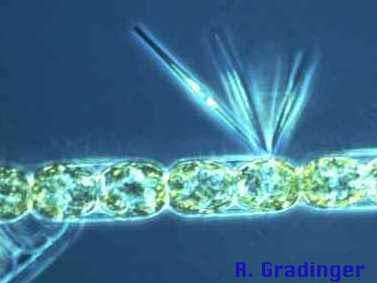
by Rick O'Connor | Nov 8, 2024
Remaining in the world of the microscopic, in this article we look at small plant-like creatures called diatoms. Diatoms are single celled algae that float in the surface waters of the Gulf of Mexico in the billions. Being plant-like, they possess chlorophyll for photosynthesis. In fact, they possess two forms of chlorophyll, and another photosynthetic pigment called fucoxanthin. Chlorophyll gives plants their characteristic green color, fucoxanthins are more yellow in color and give the diatoms the common name green-yellow algae.

Silica covered diatoms.
Photo: NOAA
To collect them scientists pull what is called a plankton net. This net is funnel shaped with the diameter of the large opening being from several inches to several feet. The mesh is of a cloth material with extremely small holes to allow water to pass but not the plankton. The plankton net is deployed off the stern of the ship/boat and towed slowly at a specific depth. Once back on board the sample can be observed in a microscope.

Plankton net.
Photo: NOAA
Diatoms are one of the more abundant microscopic plant-like algae called phytoplankton. They differ from other phytoplankters in that they do have the yellow-green color to them, but they also possess a clear glass-like shell called a frustule. This frustule is made of silica and comes in two parts. The top half is called the epitheca and the bottom half the hypotheca. The two halves fit together like the two plates of a petri dish. This frustule often has spines extending from it giving the diatom the appearance of a snowflake – and under the microscope they are beautiful. These spines actually serve a purpose. It is important they remain near the sunlit surface. To reduce sinking, these spines increase their surface area creating drag and reducing the chance they will sink. Most also produce gas pockets within the cytoplasm to make them more buoyant.
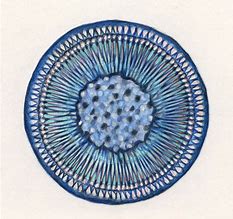
The spherical shape of the centric diatom.
Image: Florida International University
All diatoms are subdivided into two groups based on their frustule shape. Some have circular frustules and are called centric diatoms. Others are more elongated and are called pennate diatoms. Scientists currently estimate there are between 100,000 and 200,000 species of them. Though they are abundant in all the world’s oceans, they seem to be more abundant in cooler waters.
To say they play an important role in ocean ecology is an understatement. Between them and their other phytoplanktonic cousins – phytoplankton produce about 50% of the world’s oxygen. In an open ocean environment like the Gulf of Mexico where the seafloor is beyond the reach of the sun, diatoms, and other phytoplankton, are referred to as the “grasses of the sea”. They are the base of almost all marine creature’s food chain.

A phytoplankton bloom seen from space.
Photo: NOAA
When diatoms die (which is often in less than a week) their silica shells will eventually sink to the seafloor forming a layer of silica called “diatomaceous earth”. This sediment layer is commercially important as an abrasive. You will see diatomaceous earth labeled on toothpaste, household cleaners, soaps, anything with a little grit in it to help clean. It is also used in air and water filters to help purify such. You find these filters in aquariums, swimming pools, and hospitals.
If you collect a glass of water from the Gulf you are not going to see them without a microscope but know that the glass is full of these beautiful, amazing, and important marine creatures of the northern Gulf of Mexico.
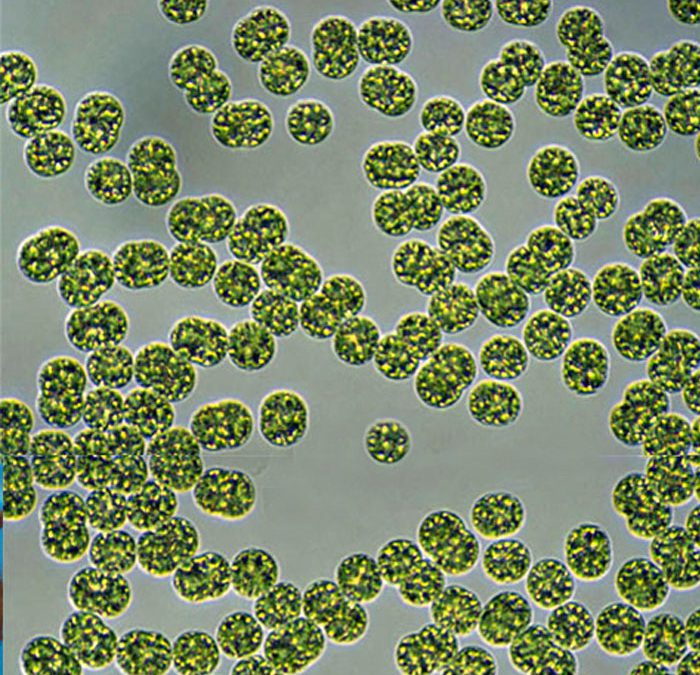
by Rick O'Connor | Oct 25, 2024
In the first article of this series, we discussed whether viruses were truly living organisms. Well, bacteria truly are. They possess all eight characteristics of life but differ from other forms of life in that they lack a true nucleus. Their genetic material just exists in the cytoplasm. This difference is large enough to place them in their own kingdom – Monera.
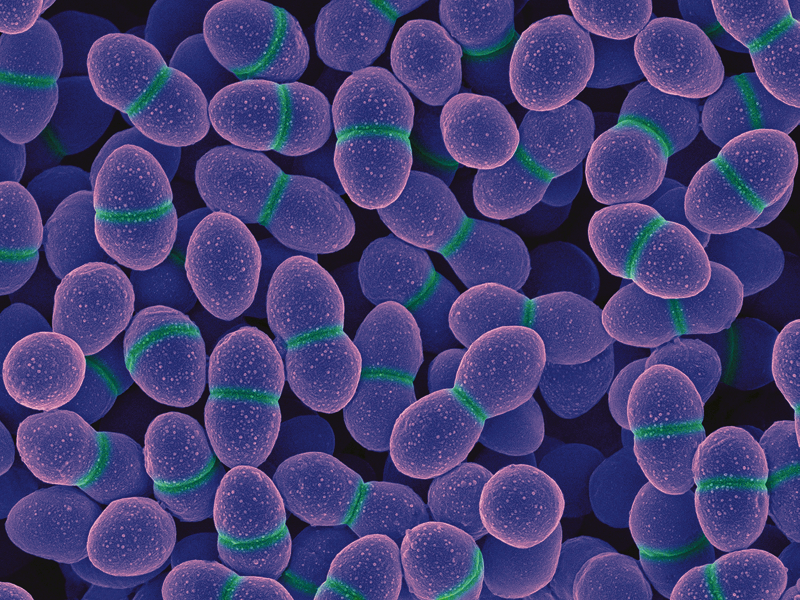
The spherical cells of the “coccus” bacteria Enterococcus.
Photo: National Institute of Health
Bacteria are single celled creatures, though some “hook” together to form long chains. A single cell will average between 5-10 microns in size. This is much larger than a virus but smaller than many eukaryotic cells (those that possess a nucleus).
To further classify bacteria microbiologists will conduct a gram-stain test. Placing a cultured sample of bacteria on a slide, you “bath” them in what is called Gram-stain. Under the microscope the bacteria that appear “pink” are called gram negative, those that appear “purple” are gram positive. Thus, all bacteria can be quickly grouped into those that are gram negative and those that are gram positive.
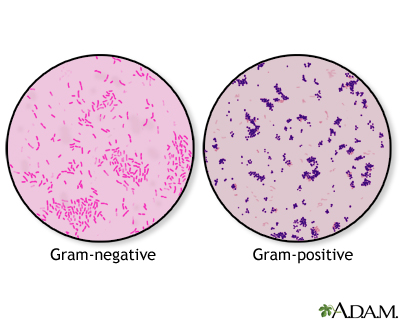
After staining, gram negative bacteria appear pink in color; gram positive are purple.
Image: University of Florida
The next level of classification focuses on the shape of their cells. Those that are “rod-shaped” are called bacillus and often have the term in their name – such as Lactobacillus the bacteria found in milk that makes milk smell sour as their populations grow. The “sphere-shaped” bacteria are called coccus – such as Streptococcus (the bacterium that causes strep throat) and Enterococcus (the fecal bacterium used for monitoring water quality in marine waters). And the third group are “spiral-shaped” and are called spirillum – such as Campylobacter and Helicobacter both are human pathogens.
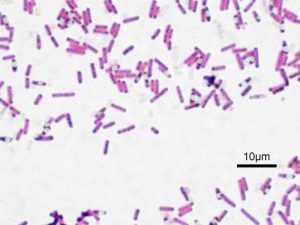
The rod-shaped bacterium known as bacillus.
Image: Wikipedia.
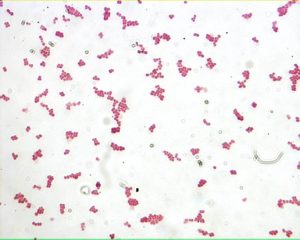
The bacterium known as coccus.
Image: Loyola University
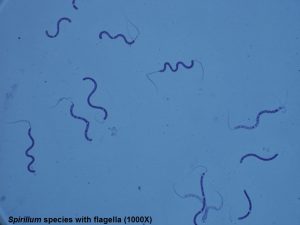
The bacterium known as spirillum.
Image: Lake Superior College.
Bacteria are very abundant in the marine and estuarine waters of the Gulf of Mexico. They can be found floating in the water column, on the surface of the sediment, beneath the surface of the sediment, and on the bodies of marine organisms. When we think of bacteria we think of “dirty” conditions and disease, but many bacteria provide very important ecological benefits to the marine ecosystem and are “good” members of the community.
One important role some bacteria play is the conversion (“fixing”) of nutrients. Animals release toxic waste when they defecate and urinate. One of these is ammonia. Ammonia can bond with oxygen depleting the body of this needed element. Nitrogen fixing bacteria can convert toxic ammonia released into the environment into nitrite. Then another group of nitrogen fixing bacteria will convert nitrite into nitrate – a needed nutrient for plants, and eventually the entire food chain.
Some bacteria are excellent decomposers. When plants and animals die we say they “decay”. What is actually happening is the decomposing bacteria are converting nutrients in their bodies to forms that are usable by living organisms. One byproduct of this decomposition process is hydrogen sulfide – which smells like rotten eggs. In biologically productive ecosystems – like swamps and marshes – the smell of hydrogen sulfide is strong – often called “swamp gas”. It is the smell of nutrient conversion and much needed. Though in high concentrations, hydrogen sulfide is toxic as well – there needs to be a balance. We see this same process happenings when we compost food waste to form fertilizers for our gardens.
One place where the smell of sulfur is very strong is near volcanic vents. If you have been to Yellowstone, or a volcano, the smell is very evident. There are what are termed “extreme bacteria” who can live in these very hot, almost toxic, environments. Just as plants take water and carbon dioxide and convert this to sugar in the process of photosynthesis, bacteria can convert toxic forms of sulfur into usable carbohydrates for other living organisms. In the 1970s marine scientists discovered thermal vents on the bottom of the ocean. These hot “chimneys” spew black clouds of smoke into the water column. Approaching these chimneys carefully they found water temperatures between 700-800°F! Living close to these chimneys they found communities of worms, shrimps, fish, and crabs. The walls of the chimneys are actually composed of sulfur fixing bacteria that are converting volcanic minerals and compounds into sugars in a process called chemosynthesis – which supports these deep-sea communities.
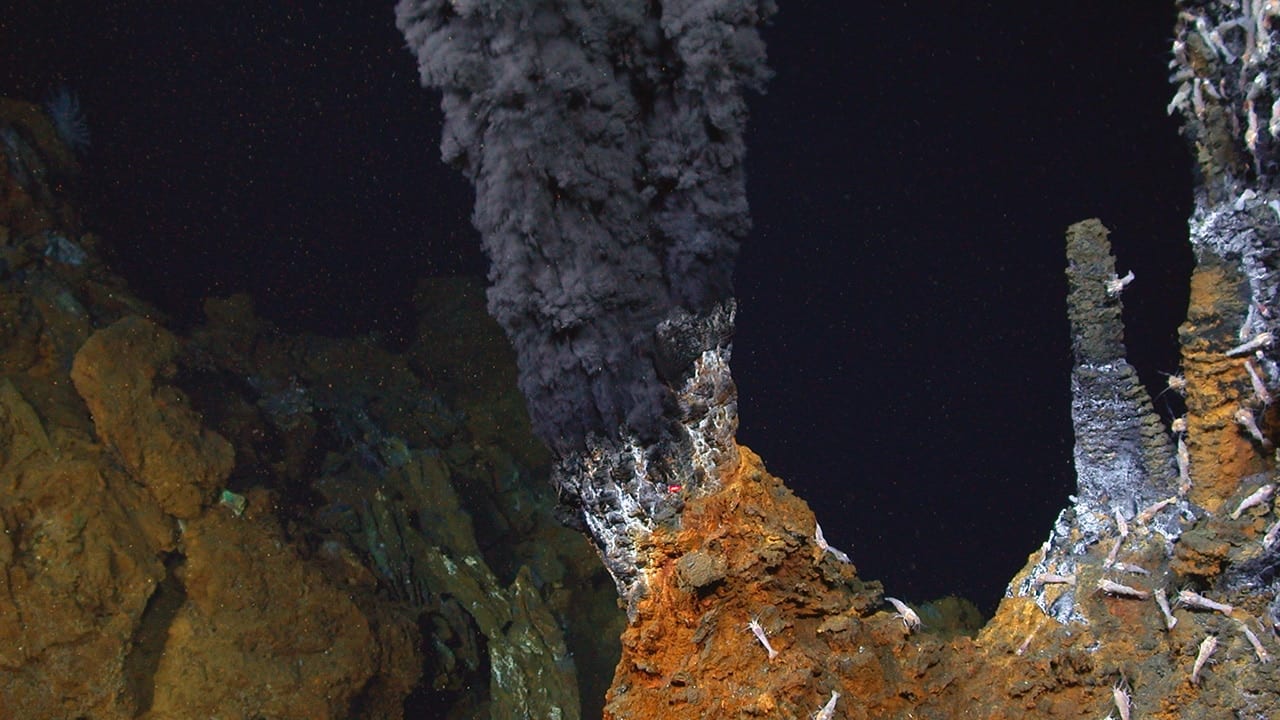
The black smokers – hydrothermal vents – found on the ocean floor.
Photo: Woodshole Oceanographic Institute.
Of course, there are more familiar forms of bacteria that cause disease. Called pathogens – they can be problems for all marine life and sometimes humans. Fecal bacteria associated with human waste are not toxic in themselves at low concentrations. However, if their numbers increase (due to a sewage spill, etc.) these, and other possible pathogenic human bacteria, can be a human health issue. The Florida Department of Health monitors the fecal bacteria levels weekly at beaches where humans like to swim. High concentrations will require the department to issue health advisories. We know that all sorts of bacteria begin to replicate quickly in warmer conditions. This can be a problem with seafood that is not kept cold enough before serving. There are federal regulations on what temperatures commercially harvested seafood must be kept in order to be served or sold to the public. Federal and state agencies can monitor the temperatures of stored seafood as it moves from the fishing vessel to the table. But they cannot monitor it from your fishing rod to your table – that responsibility will fall on you. Pathogenic bacteria is the primary reason we refrigerate and/or freeze much of our food.
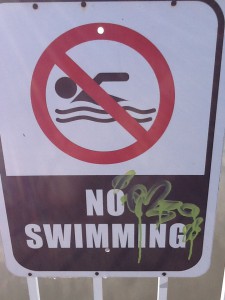
Closed due to bacteria.
Photo: Rick O’Connor
Though bacteria in general have a bad name, many species are not harmful to us and are a major player in the health of our estuarine and marine communities.
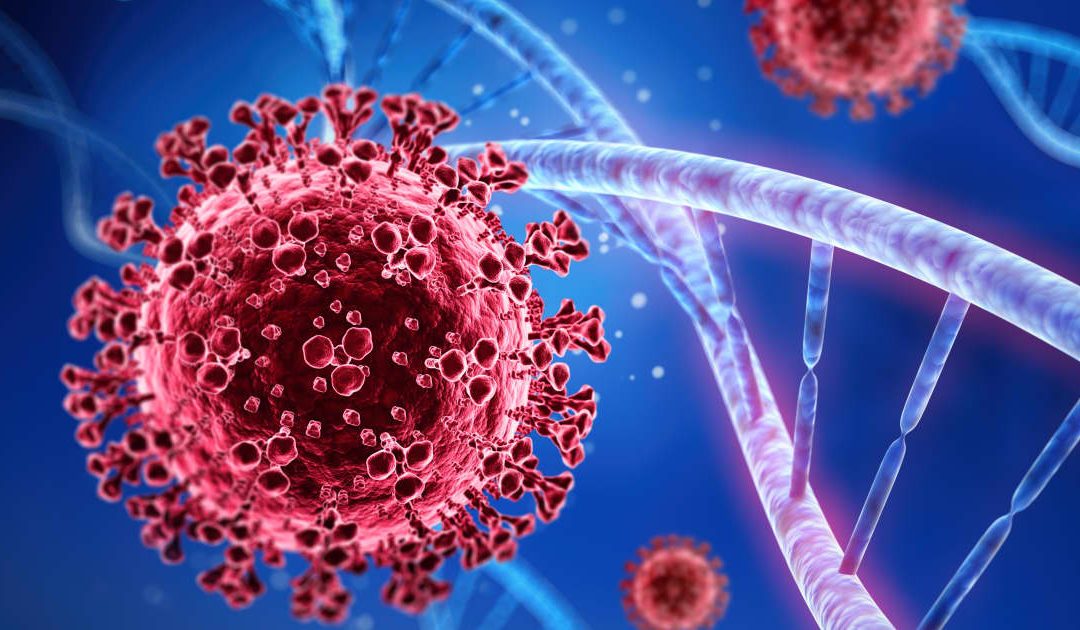
by Rick O'Connor | Oct 18, 2024
We are going to begin this series of articles with a “creature” that some do not consider alive – viruses. While studying marine science in college, and my early days as a marine science educator, there was a debate as to whether viruses were actually alive and should be included in a biology course. A quick glance at the textbooks of the time shows they were often omitted – though they were included in my microbiology class. Why were they omitted? Why did some consider them “non-living creatures”?
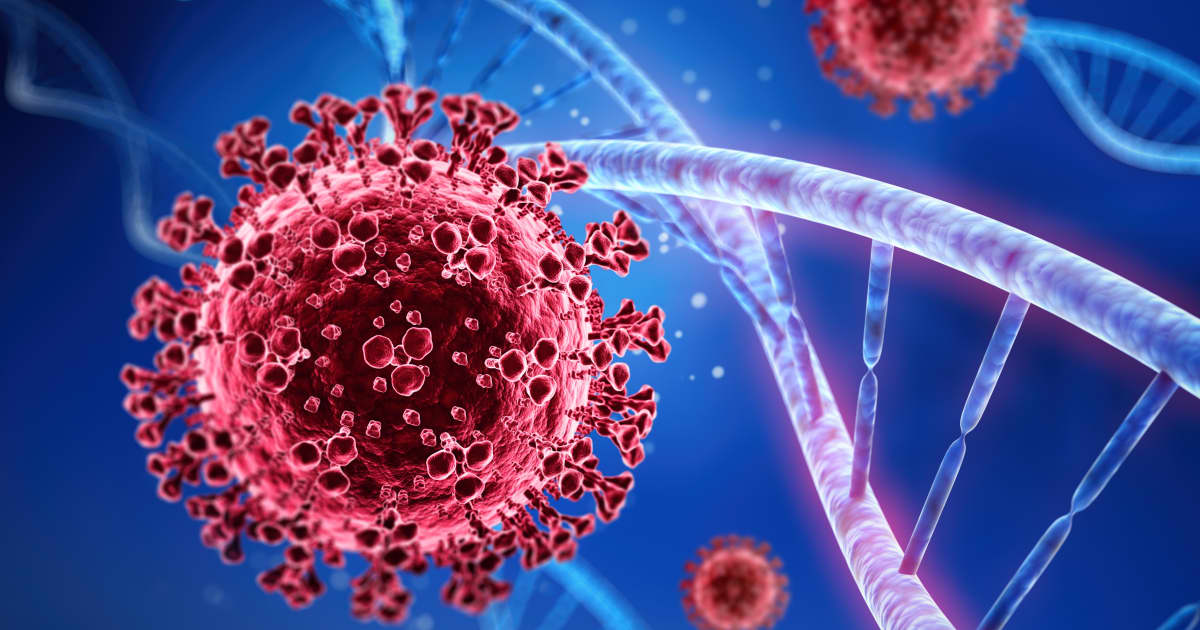
The coronavirus next to a strand of DNA.
Image: Florida International University.
Well, we always began biology 101 with the characteristics of life. Let’s scan these characteristics and see where viruses fit.
- Made of cells. This is not the case for viruses. A typical cell will include a cell membrane filled with cytoplasm and a nucleus, which is filled with genetic material (chromosomes containing DNA and RNA). An examination of a virus you will find it is either DNA or RNA encapsulated in a protein coat. It is “nucleus-like” in nature. Most cells run between 10-20 microns in size. A typical nucleus within a mammal cell will run between 5-10 microns. A typical virus would be 0.1 microns – these are tiny things – MUCH smaller than a cell.
- Process energy. Nope – they do not. Most cells utilize energy during their metabolism. Viruses do not do this.
- Growth and development. Nope again. They “spread”, which we discuss in a moment, but they do not grow. We are now 0-3.
- Homeostasis. Homeostasis is the movement of material and environmental control to remain stable – and viruses do not do this.
- Respond to stimuli. Yes… here is one they do. Studies show that viruses do respond to their chemical and physical environment.
- Metabolism. As mentioned above, this would be a no.
- Adaptation. Studies show that through very rapid reproduction they can adapt to the changing environment they are in.
- Reproduce. This is a sort of “yes/no” answer. They do reproduce (as we say – “spread”) but they do not do this on their own. They invade the nucleus within the cells of their host and replace their genetic material with that of the host creature. Then, during cell replication within the host, new viruses are produced and “spread”.
So, you can see why there is a debate. Of the eight common characteristics of life, viruses possess only three – and one of those can only be achieved with the assistance of a host creature. Now the question would be – do be labeled as a “creature” do you need ALL eight characteristics of life? Or only a few? And if only a few – how many? Because of this most biologists do not consider them alive.
During one class when we were discussing this a student made a comment – “don’t we KILL viruses? If so, then it must be alive first”. Point taken – and we should understand the phrase “kill a viruses” does not mean literally killing. It is a phrase we use. Though some argue we do kill viruses and thus…
Another point we could make here is that all life on the planet has been classified using a system developed by the Swedish botanist Carlos Linnaeus. Each creature is placed in a kingdom, then phylum, class, order, family, genus, and eventually a species name is given. We “name” the creature using its genus and species name – Homo sapiens for example. We do not see this for viruses.
All that said, both the National Oceanic and Atmospheric Administration and the National Institute of Health indicate the “most common form of life in the sea are viral-like particles” – with over 10 million in a single drop of seawater. We will leave the debate here. Your thoughts?























